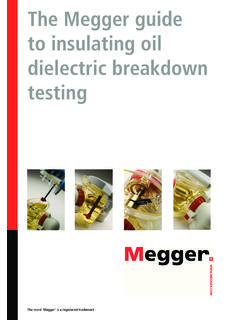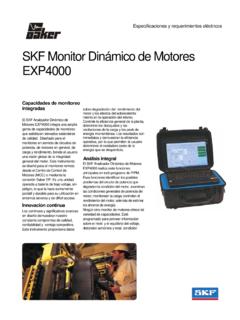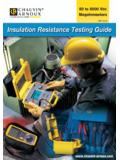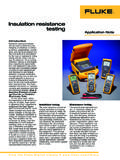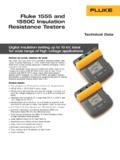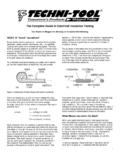Transcription of Stator insulation testing - Unitronics Electric
1 Stator insulation 1/4 Stator insulation testing : Step voltage test (EDA test) practical experience. Key Words: EDA, EDA test, step voltage test, DC test, Stator insulation , rotating machines, predictive maintenance, field testing Andr s Tabernero Garc a R&D Manager Unitronics , Madrid, Spain. EDA test has become an industrial standard in field testing of medium and high voltage rotating machines. It is a non-destructive test giving valuable information of their insulation derived from the traditional step voltage test.
2 Introduction From a long time ago, Electric engineers faced with the problems of field testing of rotating machines and standards were developed to try to normalize testing and results with the aim of get valuable information of the insulation status. It has been an evolution in field testing normative/recommendations in rotating machines from the first ones (IEEE 62-1958 EDA test basis) to the late ones: IEEE 43-2000 & IEEE 95-2002. From these ones it has evolved a test that implementing the high voltage step voltage test has become an industrial standard in common use for field testing .
3 This article describes how the machine s insulation is tested and the information reported by the test. Environmental test There is a great dependency of some results of DC testing with temperature and moisture, so it is of a great importance to have complete information of the environmental conditions while testing . The data of interest are: Ambient temperature and humidity and winding temperature. The first two parameters are measured by the instrument and the latest is user entered in the application.
4 Measured values will be normalized to temperature in order to have comparable values through time. Capacitance test EDAIII instrument capacitance test can provide a great amount of information of the insulation . Most if performed at two frequencies: first DC testing and second 1 KHz testing (both with low voltage). The differences between both measurements are going to indicate surface contamination. As can be seen in figure 1, with dc current the equivalent capacitance is the sum of the geometric + the one of all the extra capacitances of the contaminated end windings.
5 Nevertheless, when 1 KHz is used, the inductance of the coils make that extra capacitance disappear giving the capacitance variation an indication of the contamination degree [01]. Figure 1. Diagram of the equivalent circuit, where Cg= Geometric capacitance, Ri= insulation resistance, LX=Coils inductance and Cwx= contamination extra capacitance. Step Voltage (EDA test) The step voltage test consists in the insertion of a high dc voltage across the insulation (always below machine s operation voltage) lasting 30minutes Stator insulation 2/4 followed by a short circuit step to the insulation lasting 2 minutes more.
6 The circuit that performs the test is that of Figure 2. Figure 2. EDAIII working principle. S1 switches the charge step (30 ) and S2 the discharge step (2 ). The low currents are measured in nA (nanoammeter) and the equivalent circuit hanging at the right side is the same one that in figure 5. The evolution of the current can be appreciated from figures 3 and 4. Figure 5 shows the equivalent circuit of the dielectric evaluated. When first the voltage is applied, most of the current flows to charge Cg (Ic) and decays to 0 very soon (~10sec).
7 Also exists a current (IA) that decreases more slowly, charging the equivalent absorption capacitances Cax that in most of the machines is supposed to decay to 0 before the 30 minutes test period. In the end are only supposed to Figure 3. Currents flowing while the test. In black is the first voltage s current and in red the second voltage one. First 30 minutes is the charge step and follows 2 minutes discharge step. remain the currents flowing through Ri that should be composed by a conductance current through the dielectric (IG) and another leakage current mainly flowing in the surface (IL).
8 When EDA steps to short-circuit only re-absorption currents are present that correspond to the energy stored in all the Cax that wasn t dissipated while the discharge 2minutes period. Figure 4. Measured direct current (IT) is made up by the sum of three currents: Conductance (IG), Leakage (IL), Capacitance (IC) and Absorption (IA). Extracted from IEEE Std 43-2000 . The test is repeated at two different and increasing voltages (usually 2nd voltage is 2 * 1st voltage) in order to check the linearity of the insulation with voltage.
9 After the test is done, a lot of information is available in the form of parameters, all of them giving an indication of the condition of the insulation . Figure 5. Equivalent circuit of the insulation , where Cg= Geometric capacitance, Ri= insulation resistance, Rax=Absorption resistances and Cax= Absorption capacitances. The most important parameters resultants from the test are: - insulation Resistance and Polarization Index. - Time constant.
10 Stator insulation 3/4 - Absorption index. - Leakage current ratio. - Capacitances 1 KHz/DC & its ratios. - Reabsorption current. - Ratios between these parameters. The machine can be diagnosed after the test into: Reversible problems first (elsewhere reversible problems could mask irreversible problems) in which low cost operations can regain the unit into service. Once repaired this reversible problems, the unit is checked for Irreversible problems to check for its remaining life.

